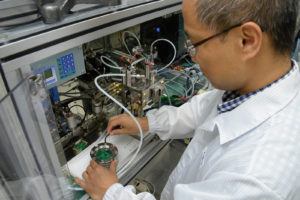
Scientists from the from the Electronics and Telecommunications Research Institute (ETRI) and Konkuk University in the Republic of Korea have developed wearable, graphene-coated fabrics that can detect dangerous gases present in the air, alerting the wearer by turning on an LED light.
The researchers coated cotton and polyester yarn with a nanoglue called bovine serum albumin (BSA). The yarns were then wrapped in graphene oxide sheets that stuck to the nanoglue so well that further testing showed the fabrics retained their electrical conducting properties after 1,000 consecutive cycles of bending and straightening and 10 washing tests with various chemical detergents. The yarns were then exposed to a chemical reduction process, which involves the gaining of electrons.
The reduced-graphene-oxide-coated materials were found to be particularly sensitive to detecting nitrogen dioxide. The fabrics were so sensitive that 30 minutes of exposure to 0.25 parts per million of nitrogen dioxide (nearly five times above the acceptable standard set by the U.S. Environmental Protection Agency) elicited a response.
According to the researchers, the new technology can be immediately adopted in related industries because the coating process is simple, making it suitable for mass production. It would allow outdoor wearers to receive relevant information about air quality. The materials could also be incorporated with air-purifying filters to act as “smart filters” that can both detect and filter harmful gas from air.
Source: ETRI
 TEXTILES.ORG
TEXTILES.ORG


